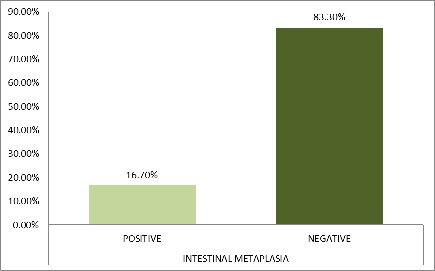Topographic study of H. pylori and gastric intestinal metaplasia in patients with dyspepsia in a tertiary health care setting.
Abstract
Background & Objectives: Dyspepsia is a relatively common clinical condition characterized by chronic / recurrent upper abdominal pain or discomfort and is often associated with one or more of following symptoms at any given time - upper abdominal pain, burning sensation in the chest or upper abdomen, regurgitation, anorexia and early satiety. The present study was done to estimate the prevalence of Intestinal Metaplasia (IM) in the stomach in unselected patients with dyspepsia and to correlate these changes with symptoms, risk factors and endoscopic findings.
Methods: We evaluated 102 patients who presented with symptoms of dyspepsia. Relevant clinical details were noted. A minimum of 9 endoscopic mucosal biopsies were taken from all subjects and in addition, biopsies were also taken from endoscopically abnormal areas. Rapid Urease Test (Standard in-house method) was done. All gastric biopsies were graded according to the Updated Sydney System. Statistical analysis was done using Chi-square test.
Results: Intestinal metaplasia (IM) was seen in 16.7% of the patients, predominantly in the antrum (10.8%) and all of them showed Type II IM. Atrophic gastritis was again seen predominantly (65.2%) in the gastric antrum and these patients had significantly less (P=0.0065) H. pylori infection. Reflux symptoms were significantly less in patients with IM.
Conclusion: We found a prevalence rate of 16.7% of Type II Intestinal Metaplasia of the stomach, which was topographically preponderant in the antrum.
Downloads
References
2. Jass JR, Filipe MI. The mucin profiles of normal gastric mucosa, intestinal metaplasia and its variants and gastric carcinoma. Histochem J. 1981 Nov;13(6):931-9.[pubmed]
3. Filipe MI, Muñoz N, Matko I, et al. Intestinal metaplasia types and the risk of gastric cancer: a cohort study in Slovenia. Int J Cancer. 1994 May 1;57(3):324-9.[pubmed]
4. Dixon MF, Genta RM, Yardley JH, et al. Classification and grading of gastritis. The updated Sydney System. International Workshop on the Histopathology of Gastritis, Houston 1994. Am J Surg Pathol. 1996 Oct;20(10):1161-81.[pubmed]
5. Pande R, Karki BB. Evaluaton of Locally made Rapid Urease Test for Diagnosis of Helicobacter Pylori. Post-Graduate Medical Journal of NAMS. 2009 Dec 29;9(02):50-53.
6. Bancroft JD, Gamble M, editors. Theory and practice of histological techniques. Elsevier health sciences; 2008.
7. Zuberi BF, Faisal N, Quraishy MS, Afsar S, Kazi LA, Kazim E. Correlation between clinical, endoscopic and histological findings at esophago-gastric junction in patients of gastroesophageal reflux disease. Journal-College Of Physicians And Surgeons Of Pakistan. 2005 Dec;15(12):774-7.
8. Prabhu SR, Amrapurkar AD, Amrapurkar DN. Role of Helicobacter pylori in gastric carcinoma. National medical journal of india. 1995 Jan 1;8(2):58-60
9. Zullo A, Hassan C, Romiti A, et al. Follow-up of intestinal metaplasia in the stomach: When, how and why. World J Gastrointest Oncol. 2012 Mar 15;4(3):30-6. doi: 10.4251/wjgo.v4.i3.30.[pubmed]
10. Ozdil K, Sahin A, Kahraman R, Yuzbasioglu B, Demirdag H, Calhan T, et al. Current prevalence of intestinal metaplasia and Helicobacter pylori infection in dyspeptic adult patients from Turkey. Hepato-gastroenterology. 2010;57(104):1563-6.[pubmed]
11. Cassaro M, Rugge M, Gutierrez O, et al. Topographic patterns of intestinal metaplasia and gastric cancer. Am J Gastroenterol. 2000 Jun;95(6):1431-8. DOI:10.1111/j.1572-0241.2000.02074.x.
12. Goh KL, Parasakthi N, Peh SC, et al. The rapid urease test in the diagnosis of Helicobacter pylori infection. Singapore Med J. 1994 Apr;35(2):161-2.[pubmed]
13. Misra V, Misra S, Dwivedi M, et al. A topographic study of Helicobacter pylori density, distribution and associated gastritis. J Gastroenterol Hepatol. 2000 Jul;15(7):737-43.[pubmed]
14. Kumar V, Abbas AK, Fausto N, Aster JC. Robbins and Cotran pathologic basis of disease, professional edition e-book. Elsevier health sciences; 2014.
15. Zhang C, Yamada N, Wu YL, Wen M, Matsuhisa T, Matsukura N. Comparison of Helicobacter pylori infection and gastric mucosal histological features of gastric ulcer patients with chronic gastritis patients. World Journal of Gastroenterology: WJG. 2005 Feb 21;11(7):976-981.
16. Riddell RH. The biopsy diagnosis of gastroesophageal reflux disease, “carditis,” and Barrett's esophagus, and sequelae of therapy. The American journal of surgical pathology. 1996 Jan 1;20:31-50.



 OAI - Open Archives Initiative
OAI - Open Archives Initiative


